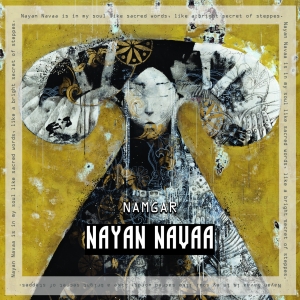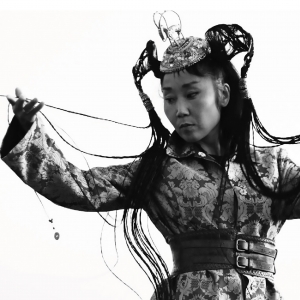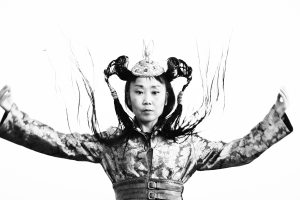Namgar: Nayan Navaa

Namgar Lhasaranova’s voice is as immense as her Siberian homeland. Praised as a “Mongolian Bjork“, she and her group, Namgar, fuse traditional Buryat and Mongolian music with elements of pop, jazz, folk, ambient soundscapes and art-rock.
Lhasaranova’s impressive vocal range can go from playful and childlike to gigantic and soaring within the space of a few minutes. The band uses traditional Mongolian instruments, including the yatag (a 13-stringed zither), the chanza (a three-stringed lute) and the morin khuur (a two-stringed bowed instrument), along with electric bass and drums to craft its unique sound, which it has been taking to festival stages around the world from Norway to Malaysia to the United States since forming in 2005.
The melodic music Namgar creates was passed down to Lhasaranova from her grandparents and father, who sang to her as a child. The inventive arrangements are new, but the stories told in the songs are as old as the indigenous Buryats themselves, with tales and myths of ancient Mongol fighters, champions, horses and famous battles.
On the occasion of the band’s album Nayan Navaa’s release, Lhasaranova took some time to reflect on this innovative and exciting new project.


“I am a Buyrat.”
“The Buryats are the indigenous people from Siberia, originating from Mongolia’s origin, with the oldest traditions and culture. I come from a small steppe village of Kunkur in the TransBaikal Territory. We live in the southern part of Siberia in Russia, near the border with Mongolia and the People’s Republic of China. Since ancient times, our nomadic people have lived in the territory located around the Lake Baikal. I like that the Buryat people are open, compassionate and keep the traditions of their ancestors. They also have a desire for study, education and knowledge of the world, and a reverent attitude to parents and the surrounding nature and religion.”
“About the folk songs.”
“It seems to me that the surrounding nature leaves its mark on the traditional songs of many people. Mountain melodies use bright melismas and the songs of the steppe people have more expanse, latitude, etc. I see this when I study Buryat songs in archival records. The songs of the Buryats delight with their versatility, diversity and beauty in the nature of Buryatia—pointed mountain ranges, forest expanses, waterfalls, lakes and endless steppes. In addition to the melodic beauty, folk songs have a hidden meaning and wisdom. Buryat folk melodies for me are an endless cosmos, the universe. Every time I listen to them, I discover new facets and beauty again and again.”


“The name “Namgar” is a Tibetan name that my grandmother gave me. It is translated from the Tibetan term “white cloud”. With the advent of Buddhism, names of Tibetan-Sanskrit origin began to appear.”
“What inspired the album: the place where I was born, the people who live there, holy places and springs, nature, fresh clean air, warm rays of the sun, endless sky, communication and just life in the steppe. Listening to the songs of your fellow countrymen in the steppe, the simple and happy life of an animal breeder, is an inspiration. Listening to these songs, you unwittingly wish everyone to enjoy this beauty. There is a desire to transmit and share them in some way.”
“A folk song is. . . a whole world, a philosophy of life, a wisdom and a soul. It has preserved the Buryat people’s traditions of everyday life, it expresses about life and conveys the wisdom of their ancestors and their behest in the melodies. Our group was brought together by a talented musician, composer Artur Pilyavin. In the beginning, we performed with Mongolian musicians/students, and now, for many years, musicians from Siberia play with us. The founder and co-organizer of the group is Evgeny Zolotarev and we have been working together for many years. I sing, Evgeny arranges. I like that Evgeny understands Buryat music subtly and deeply. The life in the steppe and the work as a animal breeder left on him a deep imprint and loyalty forever.”


“About the album:”
“Our work in the archives pushed us to record the album. We explored the songs in the archives of St. Petersburg, Moscow and Ulan-Ude/Buryatia. We collected and recorded more than 100 folk songs that you can listen to on the internet and our website. The oldest song is a melody recorded in 1912. Our desire to share these songs, to talk about them, prompted the recording of the album. The album is international, featuring musicians from Russia. We wrote the music during the pandemic and we are grateful to all our friends, musicians, who (despite the long distances and the time difference) were always in touch and gave all their spiritual beauty to our album called ‘Nayan Navaa.'”
“The album consists of both ancient songs of the Buryats and several archive melodies. These are ritual and non-ritual songs including round dances and wedding, hunting, behest and joke songs. Although I live 5,000km away from my parents, my father and I still managed to record his song. It is especially dear to me because my father (Ayusha Lhasaranov) had always dreamt of singing, he has a beautiful voice. However, he had become a shepherd and almost all his life was engaged in cattle breeding. But now, at the age of 83, his voice and his melody feature on our album, and we perform the behest song together. In several songs of the album, real archival voices sound in harmony with our arrangement.”


“About the audiences in different countries and concerts:”
“While touring we have visited different parts of the world – our tours and concerts cover the lands from Norway, Baffin Land (Nunavut province) to Malaysia, Japan, Shanghai, Europe, England, the most northern and coldest edges of Russia to Brazil, Mongolia, China to Africa. And wherever we were, it was only thanks to the ancient songs of the Buryats, which fascinate with the depth and beauty of the melodies. And wherever we are, we are happy that in different parts of the world we are all similar people – so open, joyful, peaceful, inquisitive, open, beautiful and happy! We are only guides to the songs of our ancestors. They transmit their story, their history, their wisdom through the centuries to all who are open and ready to hear and get acquainted with the song culture of the ancient people. And we thank all our viewers and all those people who we met on our way for their kindness and love for our songs. For being open and so heartily accepting these melodies. This is a great joy! I want to say friends, listen to our Buryat folk songs and get acquainted with the traditions and culture of the Buryat people through them. We will be only too happy to hear your thoughts, words and wishes!”
Thank you Namgar, for taking the time to share about your musicianship and your latest album!
Click to the left to preview this album, and click here to find it on Spotify, Apple Music, and more!

